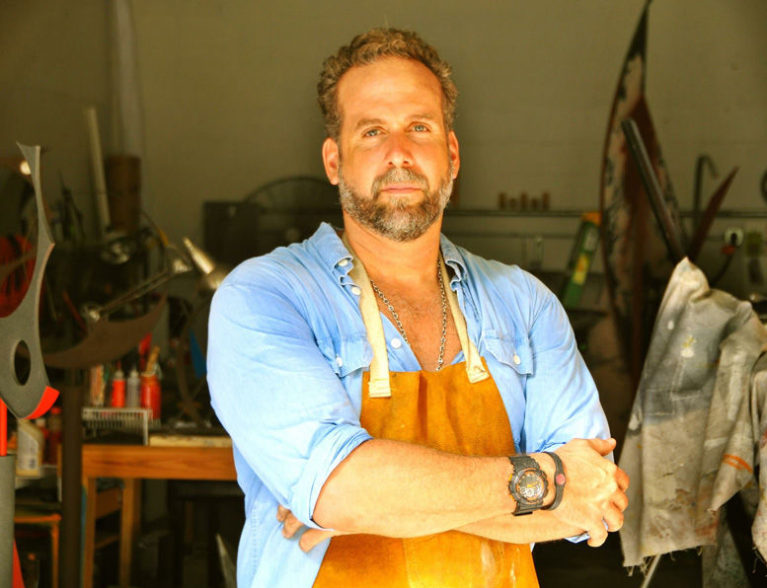
Harak Rubio is an artist who thinks big. With one eye set on art stardom, the Puerto Rican-born Rubio, now living in Melbourne, creates works of a scale that is guaranteed to make a splash.
A new solo exhibition at Melbourne’s Foosaner Art Museum, “Harak Rubio: Symbols and Guardians,” presents the artist’s latest series of elegantly minimalist paintings and sculptures. The 34 works, expertly arranged and lit by Foosaner staff, create the effect of a big-city gallery exhibition.
Right off, what strikes the eye are the paintings, large tonalist maelstroms of freely brushed and textured oil and metallic paint. Most of these bear at their centers a simple device: two fat bars of heavily stroked-on color, arranged one above the other like an insistent equal sign.
“That’s my new line of paintings,” says Rubio.
“The equal symbol is a universal symbol. I studied mathematics, and there’s a lot of mathematics in that symbol,” he says. “It’s also representative of other stuff. That’s the beauty of abstract art. People see it and can think whatever they want.”
Compared to his two-dimensional works in the show, Rubio’s free-standing sculptures favor poise over power. Both the smaller pedestal-mounted sculptures, as well as those that rise over 9 feet from the floor, are composed of gently curving ribbons of steel. They put this viewer in mind of the arrested traces of movement that a dancer might leave on the air.
Most of the sculptures are coated with a layer of textured brown-gray paint with select bits picked out in vivid red, blue, yellow, orange or green pigment. Three of the larger sculptures make use of the steel’s rust-stained natural patina, against which the sleek slivers of painted surface pop.
Rubio embodies his art. Sturdily built and 6-foot-2, he can’t be missed in a crowd, even one as dense as that at the exhibition’s opening earlier this month. In conversation Rubio is charming and, like the brushstrokes on his canvases, nimbly animated.
Rubio was 35 when he and his family moved to Melbourne from Puerto Rico 11 years ago. He wasted no time in reestablishing his art studio in Florida. Since 2003 he has created a dozen public sculptures for city, university and private collections in the United States and Puerto Rico as well as Argentina and Mexico.
Examples of Rubio’s monumental sculpture can be found within an hour’s drive of Vero. “Ocean’s Guardian,” a 16-foot-high steel sculpture, stands in Palm Bay; “Vision of the Harbor Guardian,” an aluminum sculpture with wire-brushed and blue-painted elements, is the centerpiece of downtown Melbourne’s Campbell Park.
Nature and nurture combined to make an artist of Rubio; his father Pablo Rubio is a prolific sculptor and painter, as well as a professor of art at the University of Puerto Rico.
“He is a big-league sculptor,” Harak Rubio says.
In addition to creating monumental sculptures for civic buildings, university campuses and city plazas in his native Puerto Rico, the elder Rubio has executed public sculpture commissions in Ecuador, South Korea, Spain, Venezuela and the French territory of Guadeloupe. Maestro Rubio’s exhibition record is also impressive: He was twice a member of a group of artist delegates who represented Puerto Rico in the prestigious International Biennial in Sao Paulo, Brazil.
As a kid with a famous father, did Harak ever feel intimidated by his dad’s success?
“I grew up in that environment,” Rubio responds simply.
Rubio grew up in a house designed by his father, “a paradise,” says Rubio, with a huge studio and gallery plus a guest room. Rubio remembers a comfortable childhood with plenty of encouragement – and opportunity – to express himself as an artist.
Young Rubio created his first sculpture at age 9, “because I had the talent,” he says.
“My goal in life was to be a marine biologist. I loved Jacques Cousteau. I was a big fan of his. I was fascinated about everything to do with the sea and the waves, the reef, the ecosystem.”
“When I went to university, I didn’t want to be like my dad, because art is a tough life. I saw my dad working nights, sweating and welding. I didn’t want to be like that.”
For that reason, Rubio began his college career in the biology department of the University of Puerto Rico.
When he learned that he had to take multiple courses in chemistry to earn a degree in biology, Rubio changed his major to sociology with a minor in economics. Then he went into the university’s law department, where he took an elective class in art. From there, he said, it was a matter of fate. One art class led to another.
“In my first semester of law school, I made more than 26 sculptures,” Rubio says.
“It’s like the blood calls you. And I said, what the hell am I doing here studying law?”
The study of art occupied him until age 22, when he got a job in the art department of a movie production studio in Puerto Rico. He worked on films and made-for-TV movies for such companies as Lifetime Television, USA Network and Universal Pictures, eventually seeing his name roll by in the credits as Property Master for several films.
After moving to Melbourne, Rubio continued to work in movies, but the travel involved kept him away from his wife and children – three sons and a daughter.
“It was super consuming work. It’s not like 8 to 5. Movies are 15 hours a day minimum, working every day. No holidays, no nothing.”
During this time, Rubio was also working on his art. Then he received an invitation to exhibit in an international group show.
“I said ‘OK,’ but then my art started overlapping with my movies. And you have to make a decision,” he says.
His decision to become a full-time artist is one that he does not regret. And neither does his new hometown of Melbourne.
“Harak Rubio: Symbols and Guardians” runs through Oct. 15, 2016.



